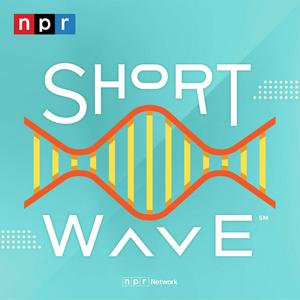1406 episódios

Drinking Turns Some Red With Asian Glow—And May Fight Tuberculosis
24/12/2025 | 13min
Ever gotten a scarlet, hot face after drinking alcohol or know someone who has? Many people felt it as they celebrate the holidays with loved ones, sipping mulled wine, cocktails or champagne. That's because this condition, commonly called "Asian flush" or "Asian glow," affects an estimated half a billion people, who can't break down aldehyde toxins that build up in their bodies. But what if there's a benefit to having Asian glow? Katie Wu, a staff writer for The Atlantic, has looked into the research as to why the condition might have been a powerful tool for some of our ancestors to survive disease. (encore episode)Questions about other potential tradeoffs for our genetics? Email us at [email protected]. We've love to hear from you and we might cover it in a future episode!Read Katie's article to learn more.Questions about other potential tradeoffs for our genetics? Email us at [email protected]. We've love to hear from you and we might cover it in a future episode!Listen to every episode of Short Wave sponsor-free and support our work at NPR by signing up for Short Wave+ at plus.npr.org/shortwave.This episode was produced by Rebecca Ramirez, edited by Berly McCoy and fact-checked by Brit Hanson. Gilly Moon was the audio engineer.Learn more about sponsor message choices: podcastchoices.com/adchoicesNPR Privacy Policy

Why Suicide Prevention is 'Everyone's Business'
23/12/2025 | 14min
Written by Jo Lambert, ‘Hold The Hope’ is now being used as suicide prevention training material by the UK’s National Health Service Mental Health Trust. Emily Kwong speaks with Rhitu Chatterjee about the inner strength of those who live with suicidality, how a song is opening up new conversations for mental health care, and how caregivers can help a person choose life, despite having persistent thoughts of death. If you or someone you know may be struggling with suicidal thoughts, contact the 988 National & Suicide Crisis Lifeline by calling or texting 988. Listen to the full version of the ‘Hold The Hope’ song hereRead more of Rhitu’s reporting on ‘Hold the Hope’ hereListen to Rhitu and Emily’s previous conversation about practical ways to help someone at risk of suicide hereInterested in more stories about mental health care? Email us your question at [email protected] to every episode of Short Wave sponsor-free and support our work at NPR by signing up for Short Wave+ at plus.npr.org/shortwave.Learn more about sponsor message choices: podcastchoices.com/adchoicesNPR Privacy Policy

No, Raccoons Aren’t Pet-Ready (Yet)
22/12/2025 | 14min
Dogs are man’s best friend. And it’s no secret that we at Short Wave love cats (Regina has four)! Both of these iconic pets have been domesticated – evolved and adapted to live alongside humans – for millennia. And a recent study suggests that the common raccoon may be on its first steps towards joining them. So how do scientists look for signs of domestication and what do those signs mean? And could you have a litter box trained raccoon in your lifetime? We talk to the study’s lead author, Raffaela Lesch, to find out.Interested in more animal science stories? Email us your question at [email protected] to every episode of Short Wave sponsor-free and support our work at NPR by signing up for Short Wave+ at plus.npr.org/shortwave.Learn more about sponsor message choices: podcastchoices.com/adchoicesNPR Privacy Policy

GLP-1 Pills Are On The Way. Here's What To Know
19/12/2025 | 12min
You may have heard of Ozempic, and other GLP-1 drugs. They’re everywhere. And they typically involve weekly injections — which can have a sticker price of over a thousand dollars a month. And insurance coverage has been tricky to navigate for a lot of people. That’s why there’s a lot of excitement around a new pill form of the drug. NPR Pharmaceuticals Correspondent Sydney Lupkin chats about these experimental pills with host Emily Kwong. Check out more of NPR’s coverage about GLP-1s.Interested in more health stories? Email us your question at [email protected] to every episode of Short Wave sponsor-free and support our work at NPR by signing up for Short Wave+ at plus.npr.org/shortwave.Learn more about sponsor message choices: podcastchoices.com/adchoicesNPR Privacy Policy

The Indicator: Take A Penny, Leave A Penny, Get Rid Of The Penny
18/12/2025 | 10min
In November, the U.S. stopped production of the humble penny after 232 years in circulation. On today’s show, Darian Woods and Wailin Wong from NPR's daily economics podcast The Indicator unpack the fiscal math that doomed the penny, and an artist pay tribute to this American icon. Follow the Indicator on Apple Podcasts or Spotify. View more of Robert Wechsler’s artwork here.Listen to every episode of Short Wave sponsor-free and support our work at NPR by signing up for Short Wave+ at plus.npr.org/shortwave.Listen to Short Wave on Spotify and Apple Podcasts.Learn more about sponsor message choices: podcastchoices.com/adchoicesNPR Privacy Policy
Mais podcasts de Notícias
Podcasts em tendência em Notícias
Sobre Short Wave
Ouve Short Wave, Comissão Política e muitos outros podcasts de todo o mundo com a aplicação radio.pt

Obtenha a aplicação gratuita radio.pt
- Guardar rádios e podcasts favoritos
- Transmissão via Wi-Fi ou Bluetooth
- Carplay & Android Audo compatìvel
- E ainda mais funções
Obtenha a aplicação gratuita radio.pt
- Guardar rádios e podcasts favoritos
- Transmissão via Wi-Fi ou Bluetooth
- Carplay & Android Audo compatìvel
- E ainda mais funções


Short Wave
descarregue a aplicação,
ouça.





































